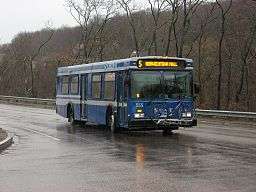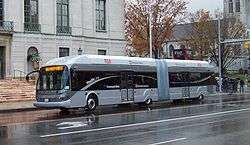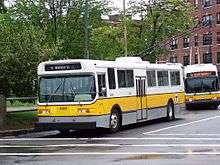New Flyer
 | |
| Public | |
| Traded as |
TSX: NFI Grey Market: NFYEF |
| Industry | Transit |
| Founded | 1930 (as Western Auto and Truck Body Works Ltd) |
| Founder | John Coval |
| Headquarters | Winnipeg, Manitoba, Canada |
Area served | Canada, United States, Latin America, Brazil, Thailand |
Key people | Paul Soubry - CEO |
| Products | Heavy-duty transit buses |
| Slogan | Built to Rely On |
| Website |
www |
New Flyer Industries Inc. is a bus manufacturer in North America, headquartered in Winnipeg, Manitoba, Canada. It also has factories in Crookston and St. Cloud, Minnesota, USA.
History
Flyer was founded by John Coval in 1930 as the Western Auto and Truck Body Works Ltd. Reflecting an increased focus on bus manufacturing, it changed its name in 1948 to Western Flyer Coach.
In the 1960s, the company further focused on the urban transit bus market. In 1971, the then-financially struggling Western Flyer was sold to the Manitoba Development Corporation, an agency of the Manitoba government, and renamed Flyer Industries Limited.[1]
On July 15, 1986, Jan den Oudsten, a descendant of the family who created the Dutch company Den Oudsten Bussen BV, purchased Flyer Industries from the Manitoba government, changing its name to New Flyer Industries Limited. Den Oudsten Bussen B.V was a bus manufacturer in its native country, the Netherlands.
New Flyer subsequently introduced North America's first low-floor bus, delivering the D40LF to the Port Authority of New York and New Jersey in 1991. Also in 1995, the first ever North American low-floor articulated bus was introduced to Strathcona County Transit of Sherwood Park, Alberta. In 2001, the delivery of 6,300 low-floor buses represented close to half of the North American fleet, confirming New Flyer as the dominant player in the transit bus manufacturing industry in North America, a role previously held by the now defunct Flxible.
In March 2002, New Flyer was acquired by KPS Special Situations Fund in New York. Also in the same year, Mr. den Oudsten retired as CEO of New Flyer Industries Ltd. and has recently been inducted into the Hall of Fame of the American Public Transportation Association.
In 2003, King County Metro of Seattle, WA placed an order for 213 hybrid buses, the largest ever for hybrid buses up to that time.[2] This record was broken when MTA New York ordered 825 hybrid buses of a different company that same year (despite they ordered between 2004 and 2007). On December 15 of the same year, New Flyer announced that Harvest Partners, Inc., a New York-based private equity firm, had entered into definitive agreements to acquire New Flyer Industries Limited, from KPS Special Situations Fund. Lightyear Capital, a New York-based private equity firm, joined Harvest as a co-investor in the transaction. John Marinucci, CEO of New Flyer, said, "This is exciting news for New Flyer" And he went on to say that KPS specializes in turning around struggling businesses and that they typically do not hold assets after the turnaround has been accomplished. And that ever since the KPS purchase, New Flyer had achieved excellent operational and financial performance. He especially praised the employees.
On August 19, 2005, New Flyer announced the closing of an initial public offering in Canada of 20,000 Income Deposit Securities, becoming a publicly traded company on the Toronto Stock Exchange. That year also saw the introduction of optional redesigned front and rear endcaps for their buses. The new endcaps are an attempt to modernize and streamline the look of their fleet, which is more or less a box on wheels. Also, a new "R" suffix was applied on all units produced with the new endcaps. The redesigned endcaps made their debut with the 2005 E40LFR built for the Vancouver trolleybus system.
Between 2005 and the end of 2009, New Flyer supplied a total of 262 low-floor trolleybuses to the Greater Vancouver Transportation Authority (now known as TransLink), of which 74 were articulated (model E60LFR). The original order, placed in late 2003, was for 188 E40LFR units and 40 E60LFR units.[3] The first E40LFR was delivered in July 2005,[4] and the rest of the 40-foot (12 m) units were delivered between August 2006[5] and September 2007.[6] The first articulated, E60LFR trolleybus arrived in Vancouver in January 2007.[7] TransLink decided to order an additional 34 articulated units, making the total 74, and delivery of the 73 production-series E60LFR units took place between October 2007 and autumn 2009.
Another purchaser of trolleybuses from New Flyer was SEPTA, operator of the Philadelphia trolleybus system. That agency placed an order with New Flyer in February 2006 for 38 E40LFR[8] "trackless trolleys", as trolleybuses are known there. The first vehicle was delivered in June 2007, and the remaining 37 were received by SEPTA during 2008.[9]
In October 2008, New Flyer Industries Canada ULC was named one of Canada's Top 100 Employers by Mediacorp Canada Inc., and was featured in Maclean's newsmagazine. Later that month, New Flyer was also named one of Manitoba's Top Employers, which was announced by the Winnipeg Free Press newspaper.[10]
The company converted to a corporate structure from a trust-like structure in October, 2011. In May 2012, New Flyer and Alexander Dennis Limited announced a new joint-venture to design and manufacture medium-duty low-floor bus (or midi bus) for the North American market. New Flyer will handle production and marketing, and Alexander Dennis will handle the engineering and testing.[11] In June 2012 New Flyer, in a joint venture with Mitsubishi Heavy Industries, the Manitoba Government, Manitoba Hydro and Red River College, unveiled a fully electric battery-powered bus.[12]
Brazilian bus manufacturer Marcopolo S.A. acquired a 19.99% stake of New Flyer on January 23, 2013 for $116-million, the maximum it could acquire without offering to buy out other shareholders.[13] New Flyer purchased Orion's aftermarket parts business from Daimler on March 1, 2013 such as inventory, accounts receivable, license to use proprietary part designs for Orion buses and included certain regulations for $29 million (it also acquired some of Orion's outstanding orders at the time of shutdown). Under the purchase, Daimler has entered into an arrangement to supply the parts to DBNA for customer warranty support.[14] On June 21, 2013, New Flyer Industries announced the acquisition of North American Bus Industries.[15][16] , and on November 10, 2015 it agreed to acquire Motor Coach Industries from KPS Capital Partners, Inc. for $459 million USD, with the deal expected to close by the end of 2016.[17]
Bus models
Each designation is preceded by a letter before the model name, which is given below.
Model designations
Current New Flyer model numbers are composed of a model code, a power source code and the length of the bus. Note that not all possible combinations have been offered.
| Model | Power | Length |
|---|---|---|
| M = MiDi X = Xcelsior |
D = diesel DE = diesel-electric hybrid E = battery-electric H = hydrogen fuel cell N = compressed natural gas T = electric trolleybus |
30 = 30 feet (9.1 m) 35 = 35 feet (11 m) 40 = 40 feet (12 m) 60 = 60 feet (18 m) articulated |
Current production
| Model | Length | Width | Introduced | Notes | Photo | |
|---|---|---|---|---|---|---|
| Xcelsior[18] | 35 feet (11 m) 40 feet (12 m) 60 feet (18 m) |
102 inches (2.6 m) | 2008-2016 |
|
  XDE60 |
 XDE40 |
| MiDi | 30 feet (9.1 m) 35 feet (11 m) |
96 inches (2.4 m) | 2013 |
|
_1415_Phlash_bus.jpg) MD35 | |
Discontinued models
| Model | Introduced | Discontinued | Maximum Seats |
Notes | Photo | ||||||
|---|---|---|---|---|---|---|---|---|---|---|---|
New Flyer Industries
| |||||||||||
| C40/C40HF D40/D40HF L40/L40HF |
1987 | 1999 |  | ||||||||
| D35/D35HF | 1988 | 1997 | |||||||||
| D60/D60HF E60/E60HF Galaxy |
1988 | 2006 |
|
 | |||||||
| D40S | 1988 | 1994 | A suburban version of the D40; manufactured only for GO Transit. | ||||||||
| C30LF D30LF |
1996 | 2009 |  | ||||||||
| C35LF D35LF DE35LF L35LF |
1996 | 2009 | Sold in the United States only. |  | |||||||
| C40LF D40LF DE40LF F40LF GE40LF L40LF |
1991 | 2013 |
|
 | |||||||
| D60LF DE60LF |
1997 | 2010 | The DE60LF was sold in the United States only. |  | |||||||
| D45S Viking |
1998 | 1999 | 104 units built for MTAs of Houston, Texas (METRO) and New York City (NYCTA). |  | |||||||
| D40i DE40i Invero |
2001 | 2007 | One of the largest customers was OC Transpo (Ottawa, Ontario). Only a small number of DE40i (hybrid diesel/electric) versions were produced, all for Roaring Fork Transportation Authority (Aspen, Colorado). |  | |||||||
| DE35LFA D40LFA C40LFA DE40LFA GE40LFA D60LFA DE60LFA |
2005 | 2010 | 35LFA available only in DE, 40LFA available only in C, D, DE or GE, 60LFA available only in D or DE versions, for BRT. |   | |||||||
| C30LFR DE30LFR |
2005 | 2014 |
|
||||||||
| C35LFR D35LFR DE35LFR GE35LFR |
2005 | 2014 | |||||||||
| C40LFR D40LFR DE40LFR E40LFR GE40LFR H40LFR HE40LF L40LFR |
2005 | 2014 |
|
 | |||||||
| D60LFR DE60LFR E60LFR |
2005 | 2014 | _on_H-1_Freeway_2011-01-04.jpg) | ||||||||
| DE41LF | 2007 | 2009 | 5 units built for the Hamilton Street Railway and 220 units built for the Southeastern Pennsylvania Transportation Authority (Philadelphia, Pennsylvania). |  | |||||||
Flyer Industries Limited A and B suffixes denoted update versions. | |||||||||||
| D700 D700A |
1968 | 1974 | 53 | Similar in appearance to the Flxible New Look. |  | ||||||
| E700 E700A |
1968 | 1973 | 53 | Trolleybus version of the D700/D700A; D700A shells sold to the Toronto Transit Commission (Toronto, Ontario) to reuse components from Canadian Car & Foundry-Brill T48 and T48A trolleybuses.[19] |  | ||||||
| D800 D800B |
1974 | 1981 | 53 | Based on the AM General Metropolitan, which itself was an updated version of the D700.[1] Offered in -9635 (96 inches [2.4 m] × 35 feet [11 m]) and -10240 (102 inches [2.6 m] × 40 feet [12 m]) versions. |  | ||||||
| E800 E800A |
1974 | 1978 | 53 | Trolleybus version of the D800/D800B. Notable operators of the E800 were the Massachusetts Bay Transportation Authority (Boston, Massachusetts) and San Francisco Municipal Railway (San Francisco, California). The E800A was delivered only to the Hamilton Street Railway (Hamilton, Ontario). |  | ||||||
| D900 | 1978 | 1980 | 53 | ||||||||
| D901 D901A |
1980 | 1986 | 53 | Revised front with rounded corners. |  | ||||||
| E901A E902 |
1982[20] | 1983[20] | 53 | This trolleybus model was only built for BC Transit (Vancouver, British Columbia). Built initially as model E901A, production continued as model E902, which may be identical (no differences between the E901A and E902 have ever been identified).[21] A total of 245 were built.[20] Eighty E901A and E902 trolleybuses were sold to EPTM (Mendoza, Argentina) in 2008. |  | ||||||
| D902 | 1984 | 1984 | 53 | This model was only built for San Francisco MUNI. |  | ||||||
| D2001 | 32 | A 30-foot (9.1 m) version of the D900 that was announced but never built. | |||||||||
| Western Flyer | 1941 | 1941 | Front engine highway coach; no official model name. | ||||||||
| T-28 | 1945 | 1945 | 28 | highway coach | |||||||
| T-32 | 1945 | 1959 | 32 | gasoline engine highway coach | |||||||
| T-36 | 1950 | 1955 | 36 | standard highway coach | |||||||
| T36-2L | 1955 | 1955 | 36 | split-level 40-2L body | |||||||
| Canuck | 1953 | diesel rear engine prototype | |||||||||
| P-37 Canuck | 1955 | 37 | gasoline rear engine | ||||||||
| C-40 | 1949 | 1955 | 40 | intercity coach | |||||||
| T-40 | 1949 | 1955 | 40 | transit version of the C-40 | |||||||
| P-37 Canuck | 1955 | 1958 | 37 | intercity coach | |||||||
| P-41 Canuck | 1958 | 1964 | 41 | diesel rear engine intercity coach | |||||||
| D500 Canuck | 1964 | 1967 | 37 | 31 feet (9.4 m) diesel rear engine | |||||||
| D600 Canuck | 1967 | 1968 | 45 | 38 feet (12 m) lengthened version of D500 | |||||||
| Buda Lo-525 | 1937 | 1941? | 32 | First bus produced by company; sold to Grey Goose Bus Lines (Winnipeg, Manitoba). | |||||||
Source: New Flyer Industries Inc.
Orion Aftermarket Parts
New Flyer acquired Orion Aftermarket Parts business for the Orion V to Orion VII bus models. New Flyer completed remaining Orion VII orders and are not producing any future Orion buses.
References
- 1 2 Stauss, Ed (1988). The Bus World Encyclopedia of Buses. Woodland Hills, CA (USA): Stauss Publications. ISBN 0-9619830-0-0.
- ↑ "New Flyer Receives Order for Up To 715 Buses From King County". Welcome to New Flyer!. New Flyer Industries Inc. Retrieved 3 October 2011.
- ↑ Trolleybus Magazine No. 254 (March–April 2004), p. 43. ISSN 0266-7452.
- ↑ Trolleybus Magazine No. 263 (September–October 2005), p. 117.
- ↑ Trolleybus Magazine No. 270 (November–December 2006), p. 135.
- ↑ Trolleybus Magazine No. 277 (January–February 2008), p. 15
- ↑ Trolleybus Magazine No. 273 (May–June 2007), p. 62.
- ↑ Trolleybus Magazine No. 267 (May–June 2006), p. 71.
- ↑ Trolleybus Magazine No. 282 (November–December 2008), p. 140.
- ↑ "Reasons for Selection, 2009 Canada's Top 100 Employers Competition".
- ↑ Archived May 31, 2012 at the Wayback Machine
- ↑ Kusch, Larry. "New Flyer green leader". Winnipeg Free Press. Retrieved 2013-04-22.
- ↑ "Brazilian bus maker loads up stake in New Flyer Industries". The Globe and Mail. 2013-01-23. Retrieved 2013-04-22.
- ↑ "New Flyer buys Orion parts business of Daimler Bus". The Globe and Mail. 2013-03-01. Retrieved 2013-04-22.
- ↑ http://www.nabusind.com/news/New_Flyer_Aquires_NABI_Closing_Press_Release.pdf
- ↑ http://www.newflyer.com/index/news-app/story.145
- ↑ "New Flyer buys Motor Coach Industries for $604M Cdn". CBCNews. November 10, 2015. Retrieved November 24, 2015.
- ↑ New Flyer Xcelsior info
- ↑ Sebree, Mac; and Ward, Paul (1974). The Trolley Coach in North America, pp. 329–332. Los Angeles: Interurbans. LCCN 74-20367.
- 1 2 3 Murray, Alan (2000). World Trolleybus Encyclopaedia. Yateley, Hampshire, UK: Trolleybooks. p. 96. ISBN 0-904235-18-1.
- ↑ Trolleybus Magazine No. 247 (January–February 2003), pp. 17–18.
Further reading
External links
| Wikimedia Commons has media related to New Flyer buses. |
| ||||||||||||||
| ||||||||||||||||||||||||||